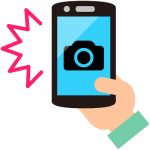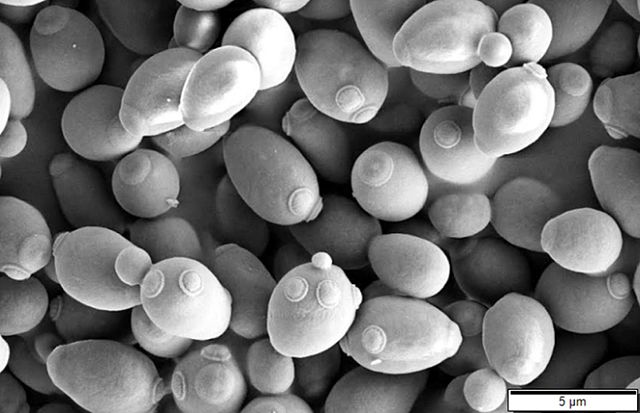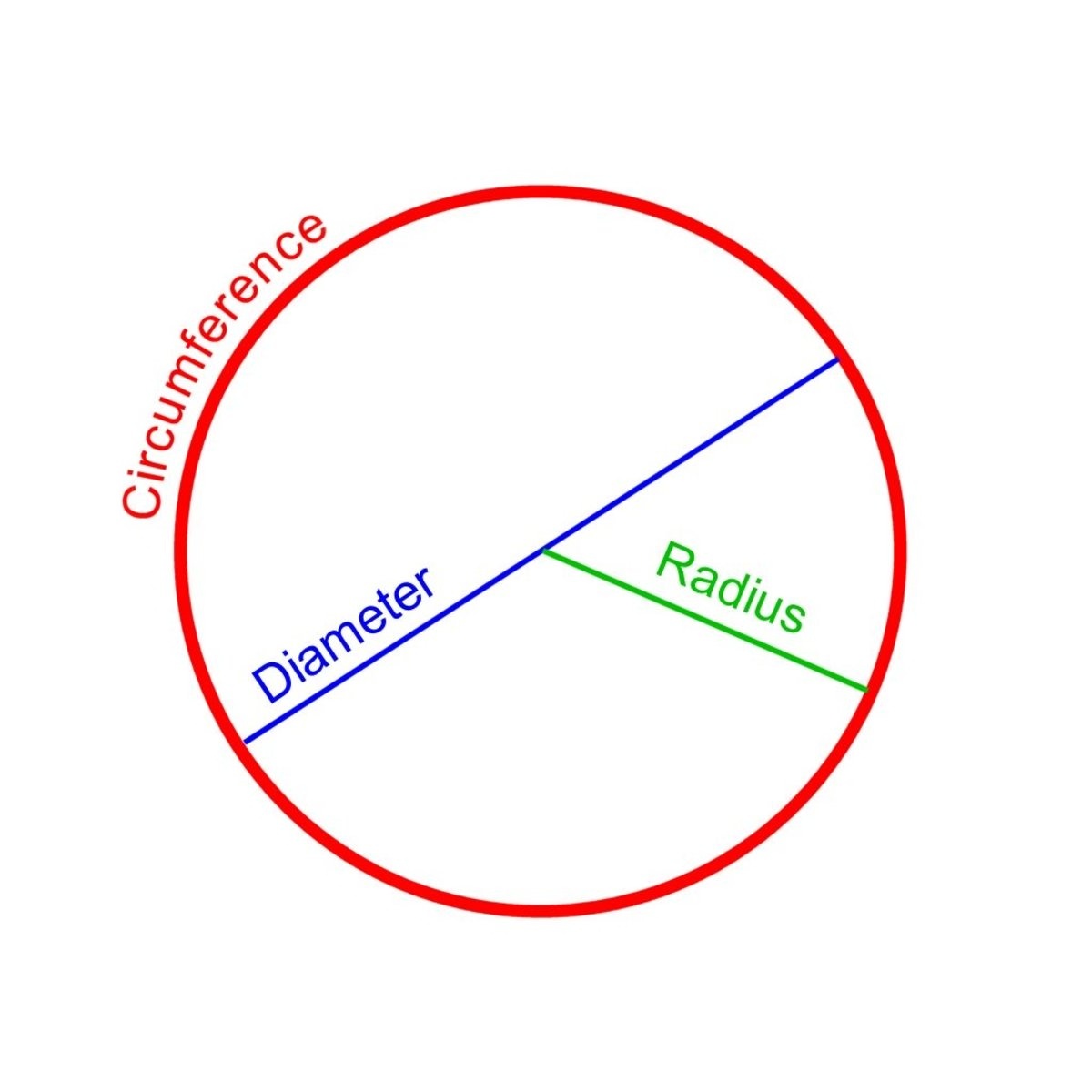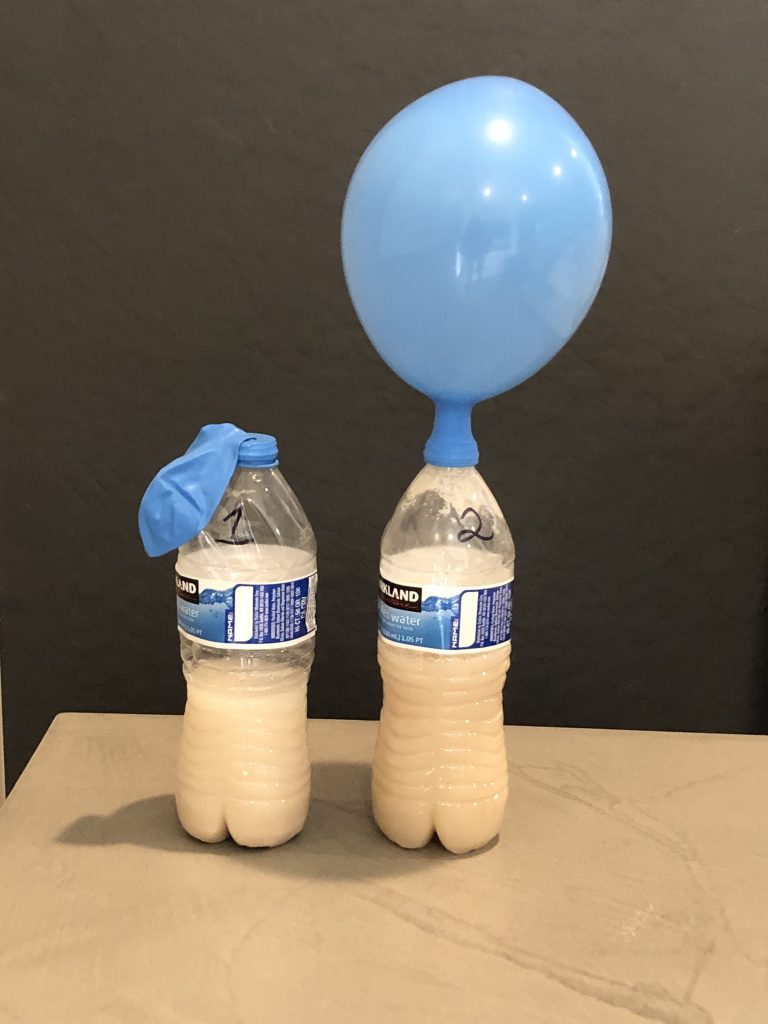FERMENTATION
LEARNING OBJECTIVES
Describe aerobic energy production.
Describe fermentation.
Determine if yeast require sugar for fermentation.
MCCCD OFFICIAL COURSE COMPETENCIES
Describe and utilize the process of scientific inquiry, its realm, and limitations.
Describe structural characteristics of the major groups of microorganisms.
Explain and demonstrate the mechanisms of microbial growth and metabolism.
NOTES
The balloons must be blown up 12 times to stretch them out before they are used in the experiment. If you do not blow up each balloon 12 times the experiment will not work.
PHOTO REQUIREMENTS
Take a photo with your photo ID during the lab exercise when you see this icon.

Paste the photo into the Fermentation Questions Document.
Relevant Test Chapters:
1st-4th edition of Microbes and Society 8.4, 9.3, 9.4, chapter 12
5th edition of Microbes and Society 5.4, 7.3, 7.4, chapter 12
INTRODUCTION
Yeasts are unicellular eukaryotic microorganisms. Yeast reproduce by budding. In budding, a small bud from the parent cell increases in size until it buds off the parent cell.

Yeast can produce ATP via aerobic energy production (cellular respiration) or fermentation depending upon environmental conditions. In the presence of oxygen, yeast produce ATP via aerobic energy production. In aerobic energy production, glucose is completely broken down into carbon dioxide and water. The equation for aerobic respiration for yeast is:
C6H12O6 (glucose) + 6O2 (oxygen) —->6CO2 (carbon dioxide)+ 6H2O (water) + 36 ATP
In the absence of oxygen, yeast produce ATP via fermentation. During fermentation, glucose is only broken down part way. Much of the energy originally available in glucose remains in the products produced. This is why fermentation produces significantly less ATP that aerobic energy production. The equation for alcohol fermentation for yeast is:
C6H12O6 (glucose)—> 2CO2 (carbon dioxide) + 2C2H5OH (alcohol) + 2 ATP
Yeast purchased at a grocery store are “active dry” yeast. The yeast are alive but are not producing ATP due to the lack of moisture. You will add active dry yeast to water or water and sugar to beverage bottles and cover the mouth of the bottles with a balloon. With no oxygen available in the bottle, the yeast will produce ATP via fermentation. The carbon dioxide produced during fermentation pushes into the balloon and inflates it. We will measure the amount of carbon dioxide produced by measuring the circumference of the inflated balloon(s).
SCIENTIFIC METHOD
Question-Is sugar required for yeast to ferment?
Hypothesis-Sugar is required for yeast to ferment.
Experimentation-You will add active dry yeast to water or water and sugar to beverage bottles and cover the mouth of the bottles with a balloon. You will measure the amount of carbon dioxide produced by measuring the circumference of the inflated balloon(s).
FERMENTATION PROCEDURE
| REQUIRED SUPPLIES FROM THE LAB KIT |
| 2 Balloons
|
| REQUIRED SUPPLIES YOU PROVIDE |
| Yeast (2 packets ; there is 2 1/4 teaspoon of yeast per packet) |
| 2 plastic water or soda bottles with lids (16.9 ounce or smaller) both bottles must be the same size and washed thoroughly |
| Cloth measuring tape (you can use thread/ribbon/yarn and a ruler to measure the thread/ribbon/yarn/string) here is a link to a printable ruler https://www.avery.com/resources/avery-printable-ruler.pdf |
| Very warm tap water (the temperature you would use to take a shower) |
| White sugar (3 Tablespoons) |
| Permanent marker |
| Cup or bowl for surface disinfectant |
| Bleach |
| Measuring spoons |
| Measuring cup |
| Paper funnel (how to make a paper funnel video https://youtu.be/M9pMtMzs2u0) |
Please watch the brief video guide below and read all instructions carefully before you start the lab exercise. Please not the video guide states to blow up the balloons three times. We are using different balloons that must be blow up at least twelve times.
1. Wash your hands thoroughly with soap and water. Dry your hands with paper towel.
2. Prepare surface disinfectant. Using the 100 ml graduated cylinder add 180 ml of tap water to a cup or bowl. Using the 100 ml graduated cylinder now add 20 ml of bleach to the cup or bowl. The surface disinfectant (10% bleach solution) is now ready to use.
3. Disinfect your work surface with the surface disinfectant by applying surface disinfectant with a paper towel, allowing it to remain damp for 2 minutes, and then wiping away any remaining disinfectant with a dry paper towel. Throw the used paper towels in the trash.
4. Blow the two balloons up twelve times to stretch them out for the experiment. If you do not blow up each balloon twelve times the experiment will not work.
5. Use the permanent maker label one of the bottles with the number 1. Label the other bottle with the number 2.
6. Use a paper funnel to add 1 package (or 2 1/4 teaspoons) of yeast to both bottles.
7. Use the paper funnel to add 3 Tablespoons of white sugar to bottle 2.
8. Gently shake bottle 2 to mix the sugar and yeast.
9. Use a measuring cup or the paper funnel to add very warm tap water to fill the bottles half way. For example, if the beverage bottle is 16.9 ounces, add 8 ounces of water. If the beverage bottle is 12 ounces, add 6 ounces of water. Use water that is warm, as if you were going to take a shower. If the water is too warm, it will kill the yeast. If the water is not warm enough, it will slow the activation of the yeast.
10. Place the lids tightly onto each bottle. Shake the bottles so there is no yeast piled on the bottom of the bottle and no big chunks of yeast floating in the water. We want all the yeast to have access to the contents of the bottle.
11. Remove the lids from the bottles. Stretch the neck of a balloon and place a balloon over the opening of each bottle. Try to keep the balloon centered on the mouth of the bottle. Every 5 minutes during the room temperature incubation, give both bottles a swirl. Let the bottles incubate for a total of 60 minutes.
12.  After the 60 minute incubation, take a photo with your photo ID of the bottles.
After the 60 minute incubation, take a photo with your photo ID of the bottles.
13. Measure the circumference (all the way around the balloon) of the fattest part of the balloons. Use a cloth measuring tape or ribbon/thread/yarn and a ruler to measure the circumference of the balloons. There is a link to a printable ruler in the Required Supplies You Provide Table above. Record your data in the data table in the Fermentation Questions Document.

14. Dispose of the bottles and balloons in the trash.
15. Disinfect your work surface with the surface disinfectant by applying surface disinfectant with a paper towel, allowing it to remain damp for 2 minutes, and then wiping away any remaining disinfectant with a dry paper towel. Throw the used paper towels in the trash. Dispose of left over surface disinfectant by pouring it down the sink and running water for at least 30 seconds.
16. Wash your hands thoroughly with soap and water. Dry your hands with paper towel.



